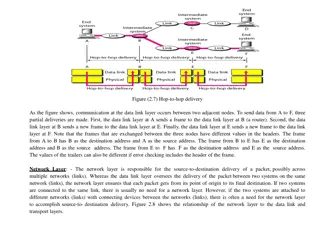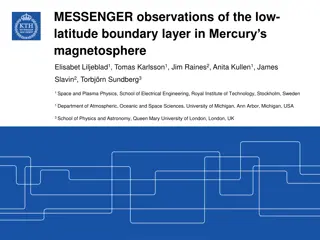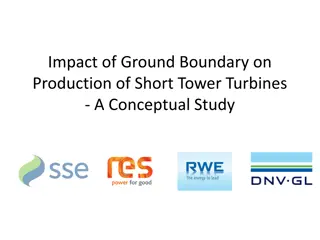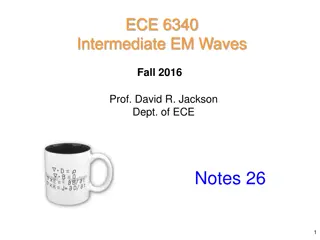
Significance of the Boundary Layer in Micrometeorology
The boundary layer (BL) plays a critical role in various meteorological processes and human activities. It influences weather forecasts, pollution dispersion, agriculture, energy extraction, and more. Understanding the significance of the BL helps in addressing environmental concerns, optimizing energy sources, and designing structures resilient to atmospheric dynamics.
Download Presentation

Please find below an Image/Link to download the presentation.
The content on the website is provided AS IS for your information and personal use only. It may not be sold, licensed, or shared on other websites without obtaining consent from the author. If you encounter any issues during the download, it is possible that the publisher has removed the file from their server.
You are allowed to download the files provided on this website for personal or commercial use, subject to the condition that they are used lawfully. All files are the property of their respective owners.
The content on the website is provided AS IS for your information and personal use only. It may not be sold, licensed, or shared on other websites without obtaining consent from the author.
E N D
Presentation Transcript
Micrometeorology Compared to the other scales of meteorological motions, turbulence is on the small end. Figure 1.15 shows a classification scheme for meteorological phenomena as a function of their time and space scales. Phenomena such as turbulence with space scales smaller than about 3 km and with time scales shorter than about 1 h are classified as microscale. Micrometeorology is the study of such small-scale phenomena. It is evident that the study of the boundary layer involves the study of microscale processes micrometeorology was often associated with surface-layer phenomena.
Additional motivation has come from concern over our environment. the consequences of its pollution and take appropriate action. Since most of the anthropogenic effluents are emitted from near-surface sources, the resulting dispersion of the pollutants is tied to boundary layer processes. As a result, air-pollution meteorology is an applied form of micrometeorology. Other applications include agricultural meteorology, where airborne transport of chemicals necessary to plant life is governed by turbulence. Nocturnal processes such as frost formation warrant improved study and forecast methods for crop protection. Fog and low stratocumulus, which inhibit aviation operations, are essentially boundary layer phenomena. Wind-generated power, a popular energy source for centuries, has had a recent increase in interest as wind turbines have been designed to extract energy more efficiently from the boundary layer wind. Other structures such as bridges and buildings must be designed to withstand wind gusts appropriate to their sites.
Significance of the Boundary Layer:- The importance of the BL is given in the following summary: People spend most of their lives in the BL. Daily weather forecasts of dew, frost, and maximum and minimum temperatures are really BL forecasts. Pollution is trapped in the BL. Fog occurs within the BL. Air masses are really boundary layers in different parts of the globe that have equilibrated with their underlying surface. The primary energy source for the whole atmosphere is solar radiation, which for the most part is absorbed at the ground and transmitted to the rest of the atmosphere by BL processes. Crops are grown in the BL. Pollen distributed by boundary layer circulations. Cloud nuclei are stirred into the air from the surface by BL processes. Virtually all water vapor that reaches the FA is first transported through the BL by turbulent and advective processes. Thunderstorm and hurricane evolution are tied to the inflow of moist BL air. Turbulent transport of momentum down through the BL to the surface is the most important momentum sink for the atmosphere. About 50% of the atmosphere's kinetic energy is dissipated in the BL. Turbulence and gustiness affects architecture in the design of structures. Warm and cold fronts separate boundary layers of different temperature. Wind turbines extract energy from the BL winds Wind stress on the sea surface is the primary energy source for ocean currents . Turbulent transport and advection in the BL move water and oxygen to and from immobile life forms like plants.
Boundary-Layer extends from the surface to between 500 and 3,000 m altitudes. Located within troposphere Surface Layer comprises the bottom 10% of the Boundary Layer. Mixed Layer area of the upward and downward motion of air resulting in a very well mixed layer of air. Very unstable Entrainment Zone area between the boundary layer and the free atmosphere. Free Atmosphere area above the boundary layer. Cloud Layer region within the boundary layer where clouds appear. Subcloud Layer region underneath the cloud layer Nocturnal Boundary layer portion of the mixed layer that loses its buoyancy at night. Very stable Residual layer : the remaining portion of the mixed layer at nigh The planetary boundary layer (PBL) is defined as the part of the atmosphere that is strongly influenced directly by the presence of the surface of the earth, and responds to surface forcings with a timescale of about an hour or less Day time boundary layer is usually very turbulent, due to ground-level heating






















